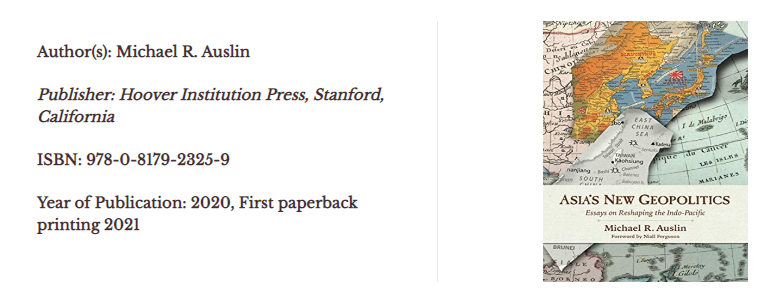
In the book “Asia’s New Geopolitics: Essays on Reshaping the Indo-Pacific”, the author, Michael R. Auslin, who is a world-renowned expert on Indo-Pacific region, Research Fellow in Contemporary Asia at Hoover Institution, Stanford University, a historian by training, who specialises in US Policy in Asia and geopolitical issues in Indo-Pacific region, examines the key issues that are changing the balance of power in Indo – China and globally and China’s aggressive global policies and strategies and its attempts to bend the world to its wishes.
What long appeared to be a static security environment in Asia has dramatically changed over past two decades. Geopolitical competition in the region threatens stability not just in Asia, but globally. The book is well-crafted and incisive research of Asia’s role in a complex, unstable world and is focused on confrontation between the United States and China, while the author sees China as a threat to regional stability and prosperity. With over half of world’s population living in countries around Pacific and Indian Ocean, Asia has increasingly become centre of world economy, accounting for around 40% of GDP. Rise of China and its expanding economic, political and military engagements are shifting strategic realities for all.
The series of eight essays which study political, military, ideological and cultural aspects of modern Asian geopolitics touch on major security issues in Indo-Pacific region, forming a comprehensive overview of current geopolitical situation in the region from U.S. perspective, providing recommendations for how U.S. might balance against China. Auslin’s argument is that it is control of “rimlands” that will determine which of the two superpowers win the struggle for mastery in Asia. He argues that global focus on China – U.S. competition for power has obscured “Asia’s other great game” – rivalry between China and Japan. He questions whether Kim-Jong-un can control his nuclear weaponry and implications for safety if he cannot.
In the book’s first section: Asia’s Mediterranean, the author addresses short-sighted focus on a single sub-region at a time as a weakness of U.S. Indo-Pacfic strategy, arguing for an approach that considers the region as a whole. This point is reiterated in essay, “The Question of American Strategy in the Indo-Pacific.” The author provides an argument for broader, more comprehensive Indo-Pacific strategy on behalf of U.S. and suggests focusing less on sub-regions and specific issues and instead maintaining broad view of Indo-Pacific.
The book’s second essay, “The New China Rules”, addresses U.S. concerns over growing Chinese influence in Indo-Pacific and beyond, pointing to China’s economic, military and cultural statecraft. Here, author refers to China as a dominant global power.
In the essay “Can Kim Jong – Un Control His Nukes? Nuclear Safety, Accident and the Specter of North Korea’s Atomic Arsenal”, Auslin argues that a nuclear accident is much more likely threat from North Korea’s arms programme than topic of nuclear escalation.
“Japan’s Eightfold Fence”, addresses Japan’s cultural foundations through lens of historiography founded on modernisation theory, integrating these approaches with broad discussion of how Japanese national identity inflects contemporary Japanese internal politics. The essay also leads to essay “China Versus Japan”, which details history behind China – Japanese regional rivalry.
In the essay, “The Sino-American Littoral War of 2025: A Future History”, the author discusses hypothetical conflict between Beijing and Washington with series of fictional attacks. An era of mistrust and current tensions could escalate into full fledge war between China and U.S., accidents on high seas and skies of Asia.
Though this book focuses on China’s growing role and confrontation between United States, Japan and other Asian countries are not left out. China has also thought to expand its influence through “String of Pearls” throughout Indian Ocean, namely ports and access points ringing Indian subcontinent and reaching to Africa and Persian Gulf region (p. 9). The author argues that Washington is not doing enough to counter Beijing’s growing influence. Chinese challenge is political, economic, military and regionwide, so must be America’s response (p. 9).
The most important theoretical innovation of this book is a new term – Asiatic Mediterranean. The author attributes this to American scholar Nicholas Spykman (1944) and superimposes these developments on Asia. The book’s main idea is that an effective response to China’s challenge requires adopting larger geostrategic picture of entire Indo-Pacific region, while American policy does not meet the threat level. The author opines that U.S. administrations have been wrong in their geopolitical assessments in Asia by believing they could change China (p. 26). What is to be done? According to Auslin, first, U.S. must redraw its mental map to adopt idea of Asiatic Mediterranean. U.S. must accept that its goal is to ensure that no aggressive power gains control over Asiatic Mediterranean. Indo-Pacific region is of strategic interest in contemporary international relations, which can be compared to role of Mediterranean in past centuries. The 2019 U.S. Department of Defense Indo-Pacific Strategy Report, which opens by stating that “Indo-Pacific is Department of Defense’s priority theatre”, announcing an explicit reorientation of U.S. defense strategy away from Atlantic and Middle East (p. 171). This policy combines maintaining balance of power and asserting America’s ability to control East Asia’s inner seas’ waters, skies, and cyber networks (p. 14).
The volume’s broad scope is commendable, but essays suffer from few weaknesses: one is failure to consistently address and pinpoint China’s motivations in the region. Another is failure to address interests and incentives of unaligned powers in the region and how these incentives might move a country to either balance against or bandwagon with China. One out-of-place essay in the book is “India’s Missing Women”, an essay that focuses on South Asia and issues of gender, identity and human rights rather than broader diplomatic and military strategy. Though insightful, the essay belongs to a different book.
Traditionally, Americans referred to this region as Asia or Asia-Pacific region and often focused on even narrower sub-regions, such as Northeast Asia or South Asia. As a result, ability to conceptualise the region as a whole has been limited. Only recently the term Indo-Pacific region is used. The new term has been designed to provide holistic view of the region and is consistent with military “area of responsibility” assigned to U.S. Indo-Pacific Command (p. 150).
The book will be helpful to researchers of Asia’s political, economic and socio-cultural processes. This collection brims with insights about future of world’s most important region. It is extremely engaging and timely discussion of U.S. strategy in midst of China’s growing influence and diminishing U.S. presence in Asia. With insightful analysis of challenges faced by U.S., Auslin reminds why U.S. cannot remain a spectator to the reshaping of regional order. What emerges from these well-crafted and incisive essays is a much better understanding of competitions critical to preserving peace and promoting prosperity. Auslin identifies critical factors that will determine whether the future for free and open societies across Indo-Pacific region remains bright or a darker future emerges. All who have a stake in that future should read this book. It must read for anyone who are interested in question how U.S. can respond to China’s ambitions to dominate East and South Asia and who are concerned with future role of U.S. in the region.


